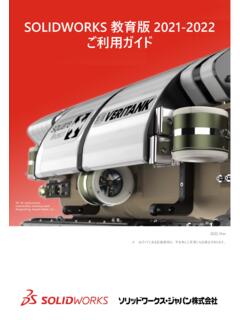Transcription of Chapter 15 Surface Modeling - SolidWorks Thai
1 CADCIM Technologies, USA. For engineering services, contact Chapter 15. Surface Modeling Learning Objectives After completing this Chapter you will be able to: Create Extruded Surface . Create Revolved Surface . Create Swept Surface . Create Lofted Surface . Create Planar Surface . Create Fill Surface . Create Radiated Surface . Offset the surfaces. Trim the surfaces. Untrim the surfaces. Extend the surfaces. Knit the surfaces. Fillet the surfaces. Create a Mid- Surface . Delete Holes. Replace the faces. Delete the faces.
2 Move and Copy the surfaces. Thicken the Surface body. Create thicken Surface cut. Create a Surface cut. 1 7/21/2003, 6:49 PM. 15-2 SolidWorks for Designers Surface Modeling . CADCIM Technologies, USA. For engineering services, contact Surface Modeling is a technique of creating a planar or non planar geometry of zero thickness. This zero thickness geometry is known as Surface . The surfaces are generally used to create models of complex shapes. You can convert Surface models in solid models. You can also extract a Surface from a solid model using the tools available for Surface Modeling .
3 This Chapter explains the Surface Modeling tools available in SolidWorks . Using these tools, you can create complex shapes as surfaces and then convert them in solid models, if required. Most of the real world components are created using solid Modeling . But sometimes, you may need to create some complex features that can only be created by Surface manipulation. This manipulation of surfaces is done using Surface Modeling . After creating the required complex Surface , you can convert it into a solid model. The reasons why you need to convert a Surface model into solid model is because a Surface is a zero thickness geometry, and so it has no mass and no mass properties.
4 In real world design, many times you need mass and mass properties of a model. The other reason is that you can generate the section view only if the model is solid. In SolidWorks , the Surface Modeling is done in the Part mode and the tools used for Surface Modeling are available in the Surfaces toolbar. This toolbar is not available by default in the Part mode. Therefore, you need to invoke it by choosing View > Toolbars > Surfaces from the menu bar. The tools used for Surface Modeling are also available in the menu bar.
5 Choose Insert > Surface from the menu bar to invoke the Surface options. You will notice that some of the tools available in the Surfaces toolbar are the same as those discussed in solid Modeling . These tools are extrude, revolve, sweep, and loft. The above mentioned tools and the other advanced Surface Modeling tools are discussed next. Creating an Extruded Surface Toolbar: Surfaces > Extruded Surface Menu: Insert > Surface > Extrude In SolidWorks , the Extruded Surface tool is provided to extrude a closed or an open sketch to create an extruded Surface .
6 An extruded Surface is created using the Surface -Extrude PropertyManager. After creating the sketch in the sketcher environment, choose the Extruded Surface button from the Surfaces toolbar. The Surface -Extrude PropertyManager is displayed as shown in Figure 15-1. The preview of the extruded Surface with the default value is also displayed in the drawing area. Using the drag handle provided in the drawing area, you can dynamically define the extrusion depth. Using the options available in the End Condition drop-down list, you can define the feature termination.
7 The feature termination options available in the Direction 1 and Direction 2. rollouts and other options are the same as those discussed in part Modeling . Figure 15-2 shows a closed sketch and Figure 15-3 shows the Surface created by extruding the closed sketch. Figure 15-4 shows an open sketch and Figure 15-5 shows the Surface created by extruding that open sketch. 2 7/21/2003, 6:49 PM. Surface Modeling 15-3. CADCIM Technologies, USA. For engineering services, contact Figure 15-1 The Surface -Extrude PropertyManager Figure 15-2 A closed sketch Figure 15-3 Surface created by extruding the closed sketch Figure 15-4 An open sketch Figure 15-5 Surface created by extruding an open sketch 3 7/21/2003, 6:49 PM.
8 15-4 SolidWorks for Designers Creating a Revolved Surface CADCIM Technologies, USA. For engineering services, contact Toolbar: Surfaces > Revolved Surface Menu: Insert > Surface > Revolve You can also create a Surface by revolving a closed or an open sketch along a centerline. Revolving a sketch along a centerline to create a Surface is similar to revolving a sketch along a centerline to create a solid feature. To create a revolved Surface , choose the Revolved Surface button from the Surfaces toolbar after creating the sketch and the centerline in the sketching environment.
9 The Surface -Revolve PropertyManager will be displayed as shown in Figure 15-6. The preview of the revolved Surface with the drag handle is displayed in the drawing area. The feature termination options and other options are similar to those discussed while revolving a solid feature. Figure 15-6 The Surface -Revolve PropertyManager Figure 15-7 shows an open sketch for creating a revolve Surface . Figure 15-8 shows the resultant revolve Surface . Figure 15-7 Sketch for creating a revolve Surface Figure 15-8 Surface created by revolving a sketch through an angle of 270-degree 4 7/21/2003, 6:49 PM.
10 Surface Modeling 15-5. Creating a Swept Surface CADCIM Technologies, USA. For engineering services, contact Toolbar: Surfaces > Swept Surface Menu: Insert > Surface > Sweep You can also create a sweep Surface by sweeping a closed or an open profile along a closed or an open path. To create a swept feature, choose the Swept Surface button from the Surfaces toolbar. The Surface -Sweep PropertyManager is displayed as shown in Figure 15-9. You are prompted to select a sweep profile. Select a closed sketch or an open sketch as the profile of the sweep feature.





